All You Need To Know About Langar Of Golden Temple
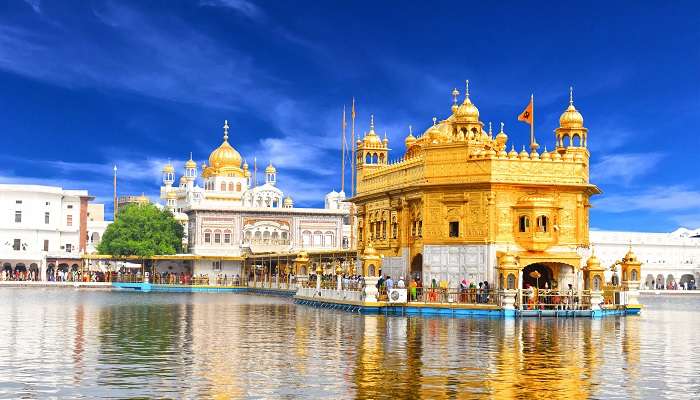
Golden Temple, also known as Sri Harmandir Sahib, is one of the most famous shrines in India that holds great significance in Sikhism. People from all walks of life are welcome here, signifying a symbol of brotherhood and equality. The langar of Golden Temple is a free community kitchen that serves thousands of devotees daily, embodying the Sikh principles of selfless service and communal harmony. Strict hygiene standards are followed during the preparation of a meal, at the time of serving, and after the devotees are done consuming the tasty langar. So, the next time you are in Amritsar, make sure to visit the Golden Temple and eat the langar.
Quick Details About Langar Of Golden Temple
Location: Golden Temple Road, Atta Mandi, Amritsar, Punjab 143006
Golden Temple timings: 24/7
Golden Temple langar timings: Meal is served at all hours
Nearby locations: Jallianwala Bagh, Durgiana Temple, Harike Wetland and Bird Sanctuary, Summer Place of Maharaja Ranjit Singh, and Wagah Border.
About The Golden Temple

Sri Harmandir Sahib (Golden Temple) is a famous Gurudwara in Amritsar, Punjab where people of all religions, castes, creeds, and ethnicities are welcomed without discrimination. Built around a man-made pool, its upper floors are adorned with gold, thereby giving its name. Inside the temple lies the Sikh holy scripture Guru Granth Sahib.
Serving meals since 1577 in its community kitchen, the gurudwara stands by the principle that there is no deed bigger than feeding the hungry. The volunteers who prepare and serve food here feel that by feeding the hungry, they are feeding God. The serene ambiance and spiritual aura of the temple make it a symbol of peace and devotion.
Must Read: Places To Visit In Punjab
The Concept Of Langar

“Langar” is a Persian word that means “a feeding center.” If we talk about a Gurudwara, langar is a community kitchen. When Sikhism came into practice, the concept of langar was already existent in Punjab, due to the influence of Muslim saints. It was Guru Nanak, the founder of the Sikh community, who incorporated the practice of langar into all the religions and castes. However, it was Guru Angad, the second Sikh Guru, who made langar a part of the Gurudwaras. Guru Amar Das, the third guru made it a compulsion that everyone, without any discrimination, is supposed to sit and eat together as equals in the gathering.
Langar is a practice followed in Sikhism, where food is served in almost every Gurudwara around the world. Free lacto-vegetarian meals and non-alcoholic beverages are served in the community hall, where thousands of people gather to eat. The number doubles up during special occasions.
“The Langar – the kitchen of the Guru’s Shabad has been opened, and its supplies never run short.”
— Guru Granth Sahib 967
Guru Ka Langar (Langar Of Golden Temple)
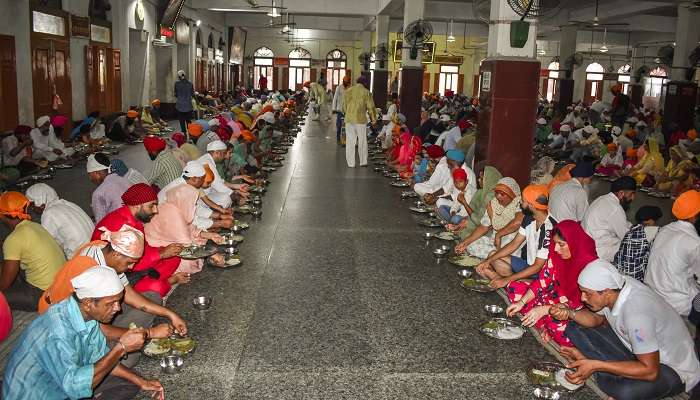
The Golden Temple has one of the biggest community kitchens running 24 hours a day. The premises have two huge dining halls where the people are made to sit on the floor, in a row or a line, as equals. The dining hall has a seating capacity of 5,000 people at a time, spread over two first-floor halls. The sewadars (religious volunteers) selflessly prepare and serve hot meals to every individual sitting cross-legged in the pangat (row/line). Daal, chapati, one kind of sabzi, and kheer (rice pudding), form a part of the servings. Drinking water is served in a small bowl instead of a glass.
In short, the delectable food at the langar of Golden Temple is prepared by the common people and served to the common people by the common people.
Suggested Read: Festivals Of Punjab
Preparation Of Langar Of Golden Temple
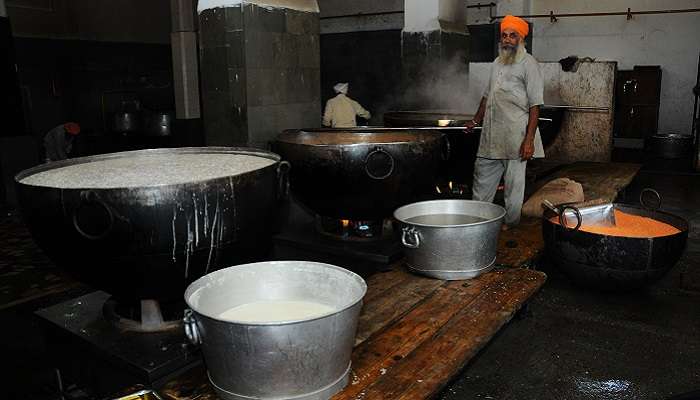
Close to 500 volunteers help in the preparation of the langar, wherein, they chop the vegetables and prepare the meals and desserts for the people. There are several machines for filtering and kneading dough and preparing chapatis in the kitchen premises. A roti-making machine donated by a devotee from Lebanon can prepare around 25,000 rotis in just an hour. Devotees recite Gurbani while preparing the langar.
The food is freshly prepared in the same pots for the entire community. When the meal is ready, a minimal portion of each dish is transferred into a stainless steel bowl and placed in front of the Guru Granth Sahib. After that, the Ardas (prayer) is recited to seek acceptance by God for the food. The minimal portion is then returned to the original pot with all the blessings of the Guru, which can now be passed on to the people through food.
In short, to keep the kitchen running smoothly, there has been constant support from the donors (in monetary terms) and the volunteers (in volitional terms). Anyone can extend their helping hand and become a volunteer by having a word with the authorities.
Hygiene Standards
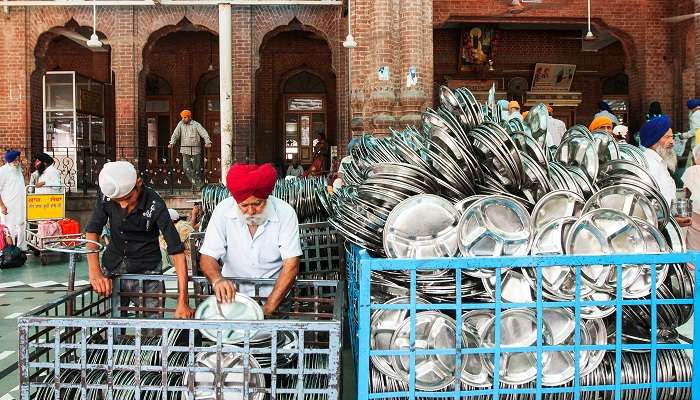
Some rules and regulations citing hygiene standards at the Golden Temple are as follows:
- Before preparing the food, sewadars must wash their hands properly and not taste the food during its preparation.
- Sewadars who are unwell should not participate in the activities related to langar, especially its preparation.
- After the individuals are done with the food, the plates are washed by sewadars five times before being used again for another serving.
- After every 15 minutes, the dining area is cleaned for the next seating of hungry devotees.
The devotees are also instructed not to leave the leftovers on their plates.
Suggested Read: Astonishing Places To Visit In Kapurthala
How To Reach Amritsar?
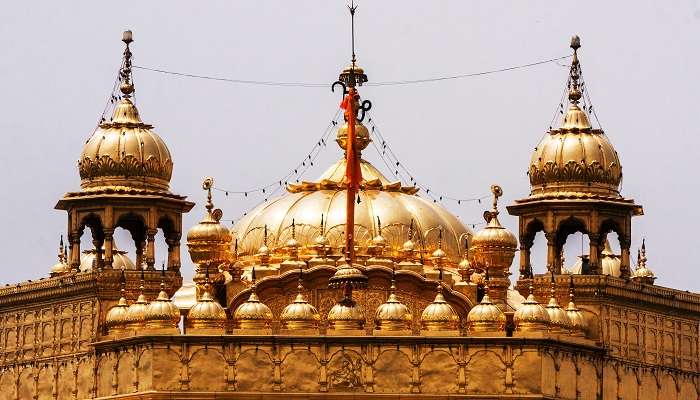
If you are arriving by flight, Sri Guru Ram Das Ji International Airport in Amritsar is approximately 13 km from the Golden Temple. Whereas, if you are arriving by train, Amritsar Railway Station is merely 2.2 km from the Golden Temple. If your preferred route is by road, there are many state-run and private buses between Amritsar and other cities in North India.
Further Read: Most Spine-Tingling Things To Do In Punjab
Now that you have all the details about the langar of Golden Temple, plan a trip to Amritsar, and don’t forget to indulge yourself in this experience of selfless service. Once you visit this pious shrine, you will be pulled by a magnet to visit this place again! So, what are you waiting for? Embark on a religious sojourn with the Golden Temple and soak in all the positive vibes!
For our editorial codes of conduct and copyright disclaimer, please click here.
Cover Image Source: Shutterstock
Frequently Asked Questions About Langar Of Golden Temple
What is Golden Temple langar?
Langar is a concept of serving free meals in the community hall where thousands of people taste the simple yet delectable food.
What is special about langar in Golden Temple?
The langar served in all the Gurudwaras is free but the unique element about the langar at Golden Temple is that it operates 24 hours a day and seven days a week.
What food is served at Langar?
Langar food in Golden Temple Amritsar is a vegetarian meal that includes daal (lentils), chapati (bread), rice, a vegetable dish, and kheer (dessert). The food served is simple and nutritious.
Where do people sit during langar?
Amritsar Golden Temple langar is served in two huge dining halls where people are made to sit on the floor in a row or a line, as equals.
What are the rules of the langar?
The langar of Golden Temple or any other gurudwara must be vegetarian, fresh & clean, to be prepared by the devotees while reciting Gurbani and served to the pangat without any discrimination after performing ardas.
People Also Read:
Places To Visit In Amritsar Things To Do In Amritsar Shopping In Amritsar

Experience the world through captivating stories of adventure and travel. As a senior content writer, I bring my passion for exploration to life, crafting tales that take you on a journey. With my words, you’ll feel the thrill of discovery and the joy of experiencing new cultures. Let me turn your imagination into a reality with stories that inspire you to explore and embrace the world.











